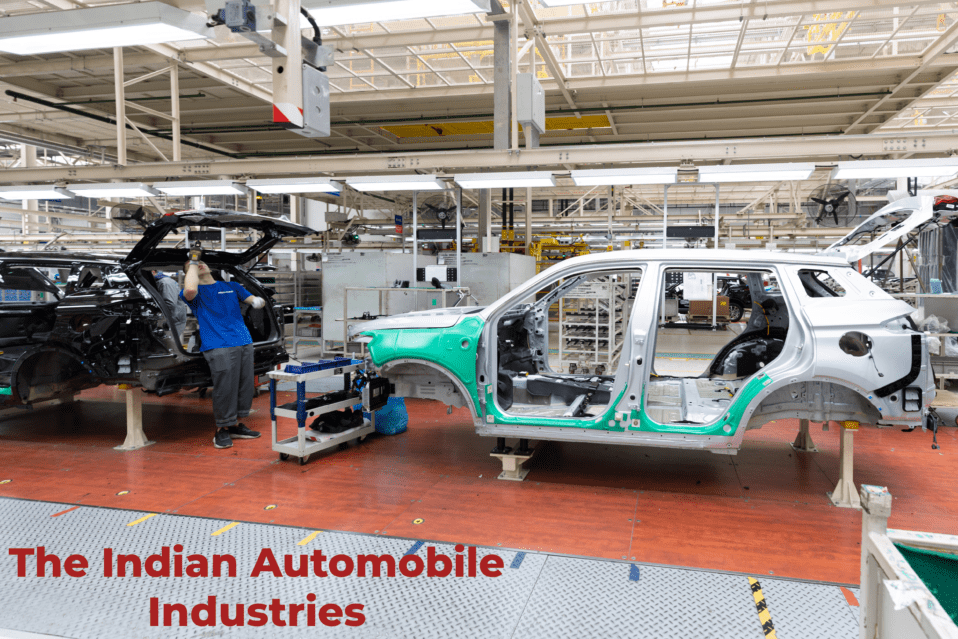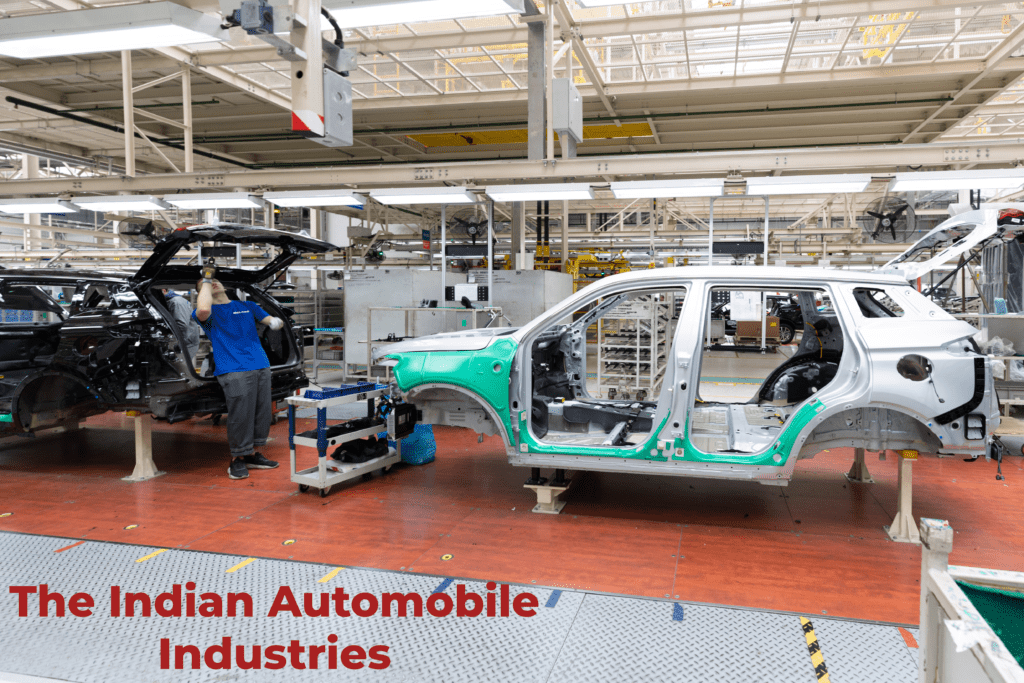

One of the most important and active sectors of the Indian economy is the automobile industry. Over time, it has developed into a major force behind economic expansion, making a substantial contribution to exports, manufacturing, and job creation. Currently ranked among the world’s largest automotive markets, India is receiving significant investments from multinational corporations in R&D and production.
This piece aims to investigate the diverse aspects of the Indian automotive business, encompassing:
- The historical evolution of the automobile industry in India
- Market size and segmentation
- Key players in the industry
- Trends shaping the future
- The impact of government policies and regulations
- The shift towards electric vehicles (EVs)
- Challenges faced by the sector
- Prospects
1. Historical Evolution of the Automobile Industry in India
The automobile sector in India has a rich history, dating back to the pre-independence era, but it began to flourish after liberalization in 1991. The opening up of the Indian economy to foreign investment was a turning point for the industry, leading to the arrival of international automakers and a significant increase in production capacity.
Key Phases of Growth:
- Before 1991: A small number of domestic automakers, such as Hindustan Motors (Ambassador) and Premier Automobiles (Premier Padmini), controlled the industry. Innovation and competition were scarce.
- Post-Liberalization (1991 onwards): Economic changes encouraged competition and innovation by opening the door for foreign companies like Suzuki, Hyundai, and Honda to enter the market.
2000s to Present: One of the global industries with the quickest growth rates is now this one. Thanks to growing disposable income, better infrastructure, and an expanding middle class, India has become the world’s fourth-largest vehicle market by volume.
2. Market Size and Segmentation.
The Indian automobile industry is highly diversified, comprising several segments including two-wheelers, passenger vehicles, commercial vehicles, and three-wheelers. Each segment plays a vital role in the overall market.
2.1 Two-Wheelers
- Market Share: Two-wheelers dominate the Indian automobile industry, accounting for nearly 80% of total vehicle sales. The market is driven by affordability, fuel efficiency and ease of commuting in congested cities.
- Key Players: Hero MotoCorp, Bajaj Auto, TVS Motor Company, and Honda Motorcycle & Scooter India are the dominant players.
2.2 Passenger Vehicles (PVs)
- Market Share: Passenger vehicles form the second-largest segment, with a focus on small cars and affordable models.
- Key Players: Maruti Suzuki, Hyundai Motors, Honda Motors, Toyota, Tata Motors, and Mahindra & Mahindra lead the PV market.
- Luxury Cars: The luxury car market is a small but growing niche, with brands like Mercedes-Benz, BMW, Audi and Land Rover making inroads into India’s urban affluent markets.
2.3 Commercial Vehicles (CVs)
- Market Share: Although they make up a lesser portion of the market, commercial vehicles such as trucks and buses are essential to the logistics and transportation sectors.
- Key Players: Tata Motors, Ashok Leyland, and Mahindra & Mahindra dominate this space
2.4 Three-Wheelers
- Market Share: Three-wheelers are a popular choice for last-mile connectivity in urban and rural areas, especially in small towns and cities.
- Key Players: Bajaj Auto, Piaggio, and Mahindra Electric lead the three-wheeler market.
3. Key Players in the Indian Automobile Industry
India’s automobile sector features a mix of domestic and international players, contributing to a highly competitive and diverse market.

3.1 Domestic Giants
- Maruti Suzuki: Maruti Suzuki, a division of Suzuki Motor Corporation, has dominated the passenger vehicle market for many years, holding almost 50% of the market.
- Tata Motors: Tata Motors is a prominent player in the domestic and international automotive markets, renowned for its extensive selection of passenger automobiles and commercial vehicles. The company owns brands such as Jaguar and Land Rover.
- Mahindra & Mahindra: Known for its SUVs and commercial vehicles, Mahindra is expanding into international markets and electric car technology.
3.2 International Automakers
- Hyundai Motors: The South Korean carmaker, renowned for its dependable and fashionable vehicles, has made a name for itself as a formidable rival in the Indian passenger vehicle industry.
- Toyota: Toyota is known for its durable and fuel-efficient cars, especially in the premium segment.
- Honda: Primarily competing in the two-wheeler and passenger car segments, Honda has been a significant player in the Indian market.
4. Trends Shaping the Future of the Indian Automobile Sector
Several trends are influencing the growth and direction of the automobile sector in India:
4.1 Electrification and the Shift to EVs
India is not an exception to the global trend of the automobile industry towards electric vehicles, or EVs. With ambitious initiatives like the Faster Adoption and Manufacturing of Hybrid and Electric Vehicles (FAME) project, the Indian government is promoting the quicker adoption of EVs. While foreign companies like Tesla are scouting the Indian market, domestic businesses like Tata Motors and Mahindra Electric are making significant investments in EVs.
4.2 Technological Advancements
- Connected Cars: IoT integration, cloud computing, and telematics are driving the development of connected vehicles in India.
- Driverless Operations: Due to infrastructure issues, fully driverless vehicles may be a ways off in India, but premium models are starting to come equipped with semi-autonomous capabilities like Advanced Driver Assistance Systems (ADAS).
4.3 Shared Mobility
Shared mobility platforms, such as ride-hailing services like Ola and Uber and car-sharing schemes like Zoomcar, are becoming more popular in India. Both car ownership models and urban transit are being affected by this shift
4.4 Sustainability and Green Initiatives
Environmental concerns are driving consumers and businesses to choose more environmentally friendly and sustainable products. This involves the continued promotion of electric vehicles (EVs) as well as the use of greener fuels like hydrogen fuel cells and compressed natural gas (CNG).
Read more latest car trends- https://www.godrivo.com/latest-car-trends/
5. Government Policies and Regulations Impacting the Sector
The Indian government plays a pivotal role in shaping the automobile industry through policies, subsidies, and regulations aimed at promoting growth and sustainability.
5.1 FAME (Faster Adoption and Manufacturing of Hybrid and Electric Vehicles) Scheme
The FAME program offers subsidies to both buyers and producers in an effort to encourage the development and purchase of electric vehicles. The scheme’s second phase, FAME II, has a strong emphasis on EV battery development, charging infrastructure, and public transportation.
5.2 Goods and Services Tax (GST)
The GST system has streamlined the tax code, bringing consistency and lowering the total amount of taxes owed on cars. Yet, greater taxes continue to apply to SUVs and premium cars, which has an effect on sales in these markets.
5.3 Emission Norms
India has reduced vehicle pollution by enacting Bharat Stage (BS) emission limits, which are based on European standards. A significant step toward cleaner emissions was the switch from BS-IV to BS-VI in April 2020, which encouraged automakers to invest in greener technologies.
5.4 Production-Linked Incentive (PLI) Scheme
The PLI scheme for the automotive industry was introduced by the Indian government in 2021, providing financial incentives to encourage exports and increase home manufacturing. Developing cutting-edge automotive technology, such as electric automobiles and vehicles that run on hydrogen, is the specific goal of this program.
6. The Shift Towards Electric Vehicles (EVs)
Despite being in its early phases, India’s electric vehicle (EV) market is expected to grow rapidly over the next ten years. The EV is predicted to play a significant role in the automobile industry because to rising environmental consciousness and government incentives.
6.1 Challenges in EV Adoption
- Lack of Charging Infrastructure: The inadequate infrastructure for charging is one of the main obstacles. While considerable progress is being made in urban areas, rural areas are still far behind.
- Battery Costs: These cars are more expensive than conventional combustion engines because of the high cost of EV batteries.
- Range Anxiety: Customers are worried about EVs’ short range, particularly considering how big India is.
6.2 Opportunities for Growth
- The Indian government aims for 30% of vehicles on the road to be electric by 2030.
- Innovative and competitive startups are entering the EV market, like Ather Energy (electric scooters) and Ola Electric (electric two-wheelers).
- The introduction of affordable electric models by established players like Tata Motors (Tata Nexon EV) is also helping to increase adoption.
Read more about Electric Cars- https://www.godrivo.com/what-is-an-electric-car-a-detailed-guide/
7. Challenges Faced by the Sector
Despite its immense potential, the Indian automotive sector is not without its difficulties.
7.1 Supply Chain Disruptions
The COVID-19 pandemic has made global supply chain problems worse, which has affected the production of automobiles. Due to shortages, prices have gone up and deliveries have been delayed for modern cars, which depend on chips.
7.2 High Taxes and Regulatory Burdens
In India, automobiles are subject to high taxes, with premium cars paying the highest rates. Furthermore, manufacturers may find it challenging to schedule long-term expenditures due to the frequent changes in policy.
7.3 Environmental Concerns
India has serious problems with air pollution, particularly in urban areas, and a major portion of the emissions are frequently attributed to the car industry. There is a lot of pressure to switch to greener options, but it will require time and money.
8. Future Prospects for the Indian Automobile Industry
The Indian auto industry appears to have a bright future since a number of variables are expected to influence its course of growth:
8.1 Electric Vehicle Boom
EVs are expected to become a dominant force in the Indian market due to the development of new technology, governmental assistance, and growing environmental concerns. India has a great deal of potential to develop into a major global EV manufacturing hub.
8.2 Expansion into Rural Markets
India’s rural areas offer a sizable untapped market, although metropolitan markets are getting close to saturation. Vehicle sales in these locations are anticipated to increase as infrastructure improves and disposable income rises.
8.3 Global Competitiveness
India is becoming a major participant in the global automotive industry as both domestic and foreign businesses establish manufacturing hubs there. Automakers find the nation appealing due to its cost-competitive manufacturing base.
Conclusion
Significant changes are about to occur in the Indian automobile industry. The automotive sector is steadily developing into a vital and dynamic aspect of the global automotive scene as it faces obstacles including electrification, sustainability, and shifting consumer behaviour. The auto industry in India is positioned for success with the correct combination of investment, government assistance, and innovation.

Comments(2)
priyanka2024 says
24/12/2024 at 4:50 pmBizupon is the perfect choice for buying a pre-owned car in japan.
We make your journey to finding the right pre-owned car smooth and easy.
japan used toyota cars for sale
Checkout the top cars at cheapest prices!!